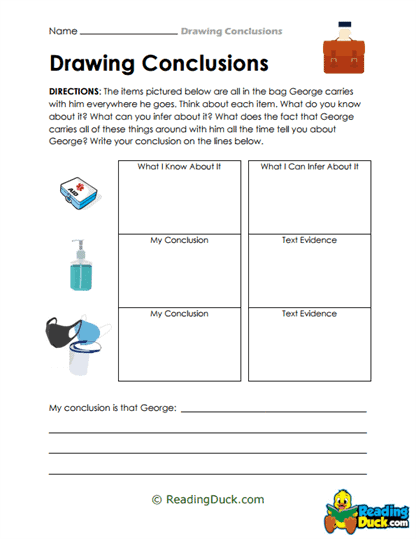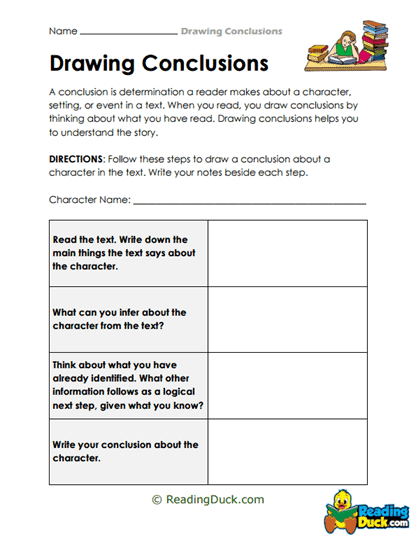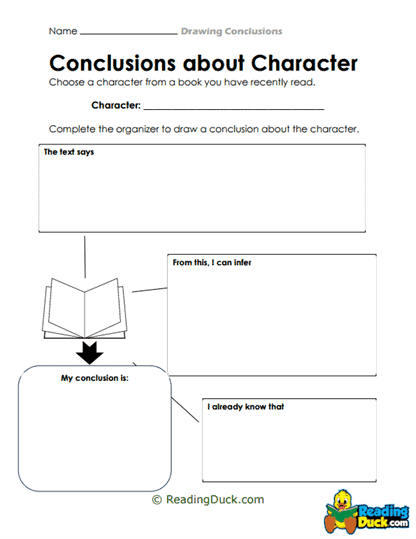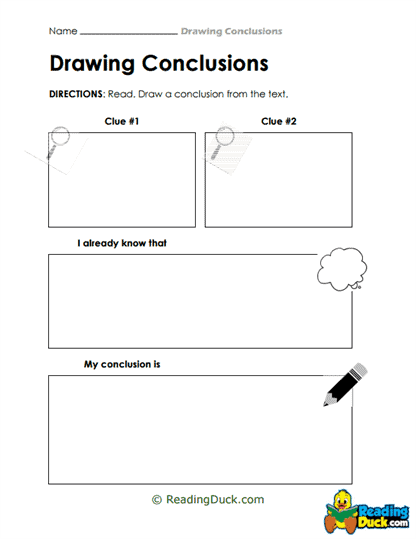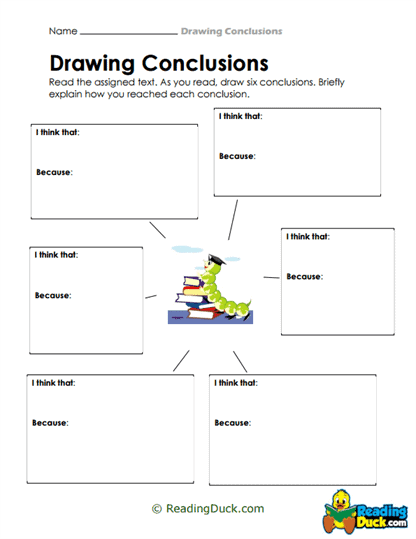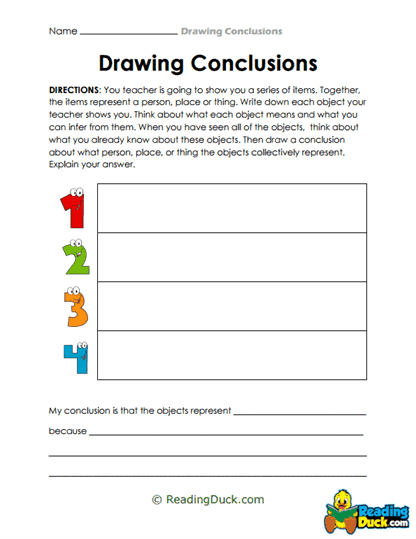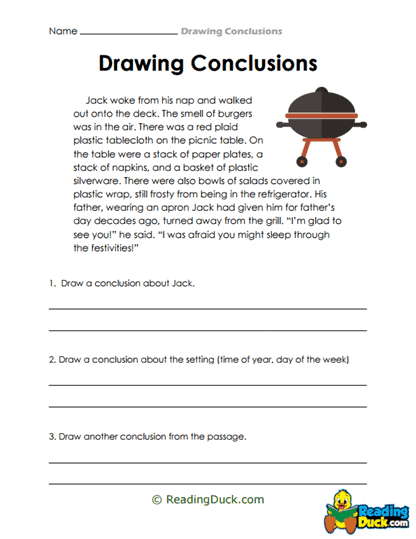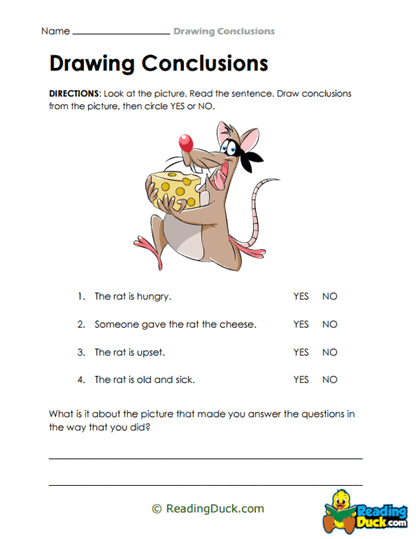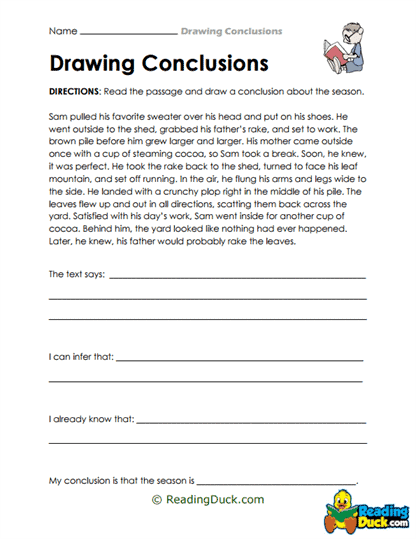Drawing Conclusions Worksheets
About Our Drawing Conclusions Worksheets
Our Drawing Conclusions Worksheets are designed to help students develop critical thinking and analytical skills by teaching them how to interpret information and make informed conclusions. These worksheets provide structured practice in reading between the lines, analyzing details, and synthesizing information to form logical and supported conclusions. This skill is essential not only in reading comprehension but also in writing, research, and problem-solving across various subjects.
Presented in convenient PDF format, the worksheets are easy to download, print, and use in any learning environment—whether in a classroom or for independent study. Each worksheet includes a downloadable answer key, offering teachers, parents, and students quick and clear feedback. These worksheets are suitable for a wide range of grade levels, making them an adaptable resource for building essential critical thinking skills in students of varying abilities.
The Importance of Drawing Conclusions
Drawing conclusions involves using information provided in a text or situation and combining it with prior knowledge or logical inference to make an educated judgment. This skill is a fundamental part of literacy, requiring students to engage actively with the text, think critically, and evaluate evidence. It is particularly important for reading comprehension, where students must often go beyond the surface meaning of the text to understand implied messages or predict outcomes.
Through our Drawing Conclusions Worksheets, students practice:
- Identifying key details: Learning to recognize the most important information in a text, which is often essential for making a logical conclusion.
- Making inferences: Understanding how to interpret implied meaning from context clues and background knowledge, rather than relying solely on explicit statements.
- Logical reasoning: Developing the ability to use evidence from a text or scenario to support a conclusion, making their analysis more robust and reasoned.
For example, students might read a passage about a character’s actions and, based on the character’s behavior and the surrounding context, draw a conclusion about what will happen next or why the character acted a certain way. This process sharpens their analytical thinking and enhances their ability to approach texts critically.
Nurturing Creativity and Independent Thought
Our Drawing Conclusions Worksheets encourage students to engage creatively with the texts and scenarios presented to them. By prompting them to think beyond what is explicitly stated, these exercises foster imagination and the ability to think critically about potential outcomes or meanings. This skill can be applied not only in academic contexts but also in everyday problem-solving and decision-making.
How these worksheets inspire creative thinking:
- Exploring multiple interpretations: Often, there is more than one valid conclusion that can be drawn from a set of facts. These worksheets encourage students to consider different possibilities and explore various interpretations of the information they are given.
- Creative problem-solving: In drawing conclusions, students must sometimes make leaps in logic that require creative thought. For example, they may need to deduce why a character in a story behaves in a certain way or predict the outcome of an event based on limited information.
- Imaginative engagement: By working with incomplete information, students are pushed to use their imagination to fill in the gaps, honing their ability to think flexibly and creatively.
These worksheets are easily adaptable to different learning paces, making them suitable for differentiated instruction. Teachers can adjust the complexity of the texts or the level of inference required to draw a conclusion, ensuring that every student—whether a beginner or an advanced reader—can benefit from the exercises.
Incorporating Drawing Conclusions into Broader Lessons
The Drawing Conclusions Worksheets can be seamlessly integrated into larger lessons or units across subjects. They serve as an excellent complement to reading comprehension activities, essay writing assignments, and even group projects, providing students with opportunities to apply their critical thinking skills in a variety of contexts.
Ideas for integrating these worksheets into broader lessons:
- Literary analysis: Use the worksheets in conjunction with novel or short story units, encouraging students to draw conclusions about character motivations, themes, or plot developments. This not only deepens their understanding of the text but also strengthens their ability to think critically about literature.
- Research projects: When conducting research, students must often draw conclusions from the data they gather. These worksheets can help prepare them for that process by providing structured practice in analyzing information and forming logical conclusions.
- Debate and discussion: After completing a worksheet, students can participate in debates or discussions where they defend their conclusions with evidence. This activity reinforces the importance of supporting claims with logical reasoning.
For example, in a social studies class, students might use a worksheet that presents a historical scenario with incomplete information. They would then draw conclusions about the outcomes of a particular event based on what they know and what is implied. This exercise encourages students to think deeply and make connections between different pieces of information.
Promoting Engagement and Motivation Through Active Learning
Our Drawing Conclusions Worksheets are designed to keep students engaged and motivated by providing interactive and thought-provoking exercises. These worksheets encourage active learning, where students must participate in the process of analyzing and interpreting information, rather than passively receiving facts.
How these worksheets engage students:
- Interactive exercises: Each worksheet requires students to think critically and make decisions based on the information provided. This active participation helps maintain student interest and fosters deeper learning.
- Real-world applications: Drawing conclusions is a skill that students use in everyday life, from interpreting news stories to making personal decisions. These worksheets show students the real-world relevance of critical thinking, motivating them to engage more fully with the material.
- Self-directed learning: With downloadable answer keys, students can work through the worksheets independently, allowing them to practice at their own pace. This helps build confidence as they see their progress and develop their reasoning skills over time.
By encouraging students to think deeply and critically, these worksheets help them become more engaged learners, better equipped to tackle complex problems both inside and outside the classroom.
Complementary Activities to Reinforce Conclusion-Forming Skills
To further enhance the skills developed through our Drawing Conclusions Worksheets, teachers can incorporate complementary activities that encourage students to apply their reasoning in new and creative ways.
Suggested complementary activities:
- Group discussions: After completing a worksheet, students can discuss their conclusions with classmates, comparing how different people interpreted the same information. This promotes collaboration and exposes students to different ways of thinking.
- Creative writing assignments: Have students write their own short stories or essays where the reader is required to draw a conclusion from the text. This allows students to apply their understanding of how conclusions are formed from written information.
- Real-world problem-solving: Present students with real-world scenarios, such as news articles or case studies, and ask them to draw conclusions based on the information provided. This helps students see the practical application of the skills they are developing.
These activities not only reinforce the skills learned in the worksheets but also provide opportunities for students to practice critical thinking in a variety of contexts.
Ideal Grade Levels and Adaptability
The Drawing Conclusions Worksheets are suitable for a wide range of grade levels, making them a flexible resource for teachers working with students of different ages and abilities.
Recommended grade levels:
- Elementary School (Grades 3-5): Introduce students to the basics of drawing conclusions with simpler texts and guided exercises that focus on key details and inference.
- Middle School (Grades 6-8): Engage students with more complex texts and scenarios that require deeper analysis and the ability to connect multiple pieces of information.
- High School (Grades 9-12): Challenge students with advanced texts that require them to draw nuanced conclusions based on subtle hints, fostering higher-level critical thinking skills.
These worksheets can be adapted to suit the needs of any learning environment, whether in a traditional classroom, homeschooling setting, or independent study program. Teachers can easily adjust the difficulty of the exercises to match their students’ abilities, ensuring that all learners can engage meaningfully with the material.
Supporting Project-Based Learning and Real-World Application
Our Drawing Conclusions Worksheets are an excellent resource for project-based learning, allowing students to apply their critical thinking skills to real-world contexts and collaborative projects.
Project-based learning ideas:
- Research projects: Use the worksheets to help students practice drawing conclusions from research data, preparing them for more complex research assignments and presentations.
- Debate preparation: Encourage students to draw conclusions about controversial issues, then use those conclusions to prepare for debates where they must defend their positions with evidence.
- Literature projects: Assign students a novel or play, then ask them to draw conclusions about key themes or character developments, using evidence from the text to support their analysis.
By integrating these worksheets into project-based learning, students gain valuable experience applying their critical thinking skills in dynamic, real-world contexts.
Conclusion
Our Drawing Conclusions Worksheets are an essential tool for developing critical thinking, reading comprehension, and writing skills. With their structured exercises, creative prompts, and focus on logical reasoning, these worksheets provide students with the skills they need to analyze information and make informed decisions. Adaptable to a variety of grade levels and learning environments, these worksheets offer a flexible and engaging resource for educators, parents, and students seeking to strengthen essential academic skills.
